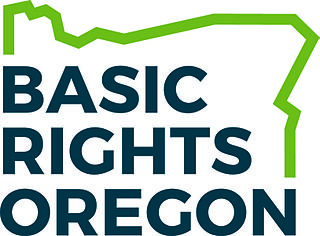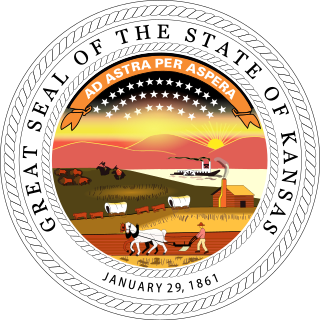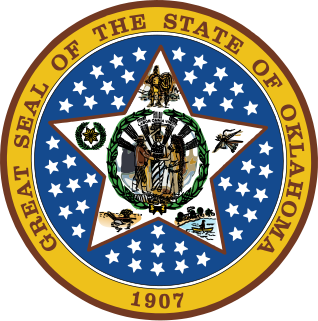Ballot Measure 9 was a ballot measure in the U.S. state of Oregon in 1992, concerning gay rights, pedophilia, sadism, masochism, and public education, that drew widespread national attention.

In political science, an initiative is a means by which a petition signed by a certain minimum number of registered voters can force a public vote in parliament called an indirect initiative or via a direct initiative, the latter then being dubbed a Popular initiated Referendum.

In the United States, a state is a constituent political entity, of which there are currently 50. Bound together in a political union, each state holds governmental jurisdiction over a separate and defined geographic territory and shares its sovereignty with the federal government. Due to this shared sovereignty, Americans are citizens both of the federal republic and of the state in which they reside. State citizenship and residency are flexible, and no government approval is required to move between states, except for persons restricted by certain types of court orders. Four states use the term commonwealth rather than state in their full official names.

Oregon is a state in the Pacific Northwest region on the West Coast of the United States. The Columbia River delineates much of Oregon's northern boundary with Washington, while the Snake River delineates much of its eastern boundary with Idaho. The parallel 42° north delineates the southern boundary with California and Nevada. Oregon is one of only three states of the contiguous United States to have a coastline on the Pacific Ocean.
Measure 9 would have added the following text to the Oregon Constitution:
All governments in Oregon may not use their monies or properties to promote, encourage or facilitate homosexuality, pedophilia, sadism or masochism. All levels of government, including public education systems, must assist in setting a standard for Oregon's youth which recognizes that these behaviors are abnormal, wrong, unnatural and perverse and they are to be discouraged and avoided.
Homosexuality is romantic attraction, sexual attraction or sexual behavior between members of the same sex or gender. As a sexual orientation, homosexuality is "an enduring pattern of emotional, romantic, and/or sexual attractions" to people of the same sex. It "also refers to a person's sense of identity based on those attractions, related behaviors, and membership in a community of others who share those attractions."
Pedophilia is a psychiatric disorder in which an adult or older adolescent experiences a primary or exclusive sexual attraction to prepubescent children. Although girls typically begin the process of puberty at age 10 or 11, and boys at age 11 or 12, criteria for pedophilia extend the cut-off point for prepubescence to age 13. A person must be at least 16 years old, and at least five years older than the prepubescent child, for the attraction to be diagnosed as pedophilia.
It was defeated in the November 3, 1992 general election with 638,527 votes in favor, 828,290 votes against. [2]
A general election is an election in which all or most members of a given political body are chosen. These are usually held for a nation's primary legislative body, as distinguished from by-elections and local elections.
Political context
The ballot measure was an effort of the Oregon Citizens Alliance (OCA), a conservative group active in Oregon politics in the 1990s. [3] Supporters of the measure felt that their traditional values were under siege in the face of growing acceptance of homosexuality by society. [4] Opponents stated that the measure was unfairly discriminatory, that it was unconstitutional, and that it demonstrated the homophobia and bigotry of its backers. Republican Senator Mark Hatfield opposed the measure, as did most Oregon newspapers. Opponents outspent the OCA six to one. [5]
The Oregon Citizens Alliance (OCA) was a conservative Christian political activist organization, founded by Lon Mabon in the U.S. state of Oregon. It was founded in 1986 as a vehicle to challenge then–U.S. Senator Bob Packwood in the Republican primaries, and was involved in Oregon politics from the late 1980s into the 1990s.
Homophobia encompasses a range of negative attitudes and feelings toward homosexuality or people who are identified or perceived as being lesbian, gay, bisexual or transgender (LGBT). It has been defined as contempt, prejudice, aversion, hatred or antipathy, may be based on irrational fear, and is often related to religious beliefs.

Mark Odom Hatfield was an American politician and educator from the state of Oregon. A Republican, he served for 30 years as a United States Senator from Oregon, and also as chairman of the Senate Appropriations Committee. A native Oregonian, he served in the United States Navy in the Pacific Theater during World War II after graduating from Willamette University. After the war he earned a graduate degree from Stanford University before returning to Oregon and Willamette as a professor.
The OCA would go on to back Measure 13, which would have prevented schools from using materials that were deemed to "legitimize homosexuality", and Measure 19. They also backed another measure numbered 9 ("son of 9") in 2000. All these were unsuccessful.
Full text
Be it Enacted by the People by the State of Oregon:
PARAGRAPH 1. The Constitution of the State of Oregon is amended by creating a new section to be added to and made a part of Article I and to read:
SECTION 41 (1) This state shall not recognize any categorical provision such as "sexual orientation," "sexual preference," and similar phrases that include homosexuality, pedophilia, sadism or masochism. Quotas, minority status, affirmative action, or any similar concepts, shall not apply to these forms of conduct, nor shall government promote these behaviors.
(2) State, regional and local governments and their properties and monies shall not be used to promote, encourage, or facilitate homosexuality, pedophilia, sadism or masochism.
(3) State, regional and local governments and their departments, agencies and other entities, including specifically the State Department of Higher Education and the public schools, shall assist in setting a standard for Oregon's youth that recognizes homosexuality, pedophilia, sadism and masochism as abnormal, wrong, unnatural, and perverse and that these behaviors are to be discouraged and avoided.
(4) It shall be considered that it is the intent of the people in enacting this section that if any part thereof is held unconstitutional, the remaining parts shall be held in force. [6]
Paraphilia is the experience of intense sexual arousal to atypical objects, situations, fantasies, behaviors, or individuals. Such attraction may be labeled sexual fetishism.
This is a list of notable events in the history of LGBT rights that took place in the year 1992.

Ballot Measure 36 was a 2004 initiative in the U.S. state of Oregon. It amended the Oregon Constitution to define marriage as a union of one man and one woman. The initiative passed with 1,028,546 votes in favor, and 787,556 votes against in the November 2, 2004 general election.
It is one of a number of U.S. state constitutional amendments banning same-sex unions.
Homosexual agenda is a term introduced by sectors of the Christian religious right as a disparaging way to describe the advocacy of cultural acceptance and normalization of non-heterosexual orientations and relationships. The term refers to efforts to change government policies and laws on LGBT rights-related issues. Additionally, it has been used by social conservatives and others to describe alleged goals of LGBT rights activists, such as recruiting heterosexuals into what they term a "homosexual lifestyle".

Basic Rights Oregon is an American nonprofit LGBT rights organization based in Portland, Oregon. It is the largest advocacy, education, and political organization working in Oregon to end discrimination based on sexual orientation and gender identity. Basic Rights Oregon has a full-time staff, a contract lobbyist, and more than 10,000 contributors, and 5,000 volunteers. It is a 501(c)(4) organization that maintains a 501(c)(3) education fund, a state candidate PAC and a ballot measure PAC. The organization is a member of the Equality Federation.

Ballot Measure 19 was a citizen's initiative in the U.S. state of Oregon in 1994. The measure sought to amend the Oregon Constitution, limiting free speech protection for obscenity and child pornography. The measure was rejected by the voters 54.3 percent to 45.7 percent.

Colorado Amendment 43 was a referendum approved by the voters in 2006 that added a new section to Article II of the Colorado Constitution to define marriage in Colorado as only a union between one man and one woman. It passed with 56% of the vote.

Ballot Measure 2 of 1998 is a ballot measure, since ruled unconstitutional, that added an amendment to the Alaska Constitution that prohibited the recognition of same-sex marriage in Alaska. The Ballot measure was sparked by the lawsuit filed by Jay Brause and Gene Dugan, after the two men were denied a marriage license by the Alaska Bureau of Vital Statistics. In Brause v. Bureau of Vital Statistics, 1998 WL 88743, the Alaska Superior Court ruled that the state needed compelling reason to deny marriage licenses to same-sex couples and ordered a trial on the question. In response, the Alaska Legislature immediately proposed and passed Resolution 42, which became what is now known as Ballot Measure 2. Ballot Measure 2 passed via public referendum on November 3, 1998, with 68% of voters supporting and 32% opposing. The Bause case was dismissed following the passage of the ballot measure.

Wisconsin Referendum 1 of 2006 was a referendum on an amendment to the Wisconsin Constitution that would invalidate same-sex marriages or any substantially similar legal status. The referendum was approved by 59% of voters during the general elections in November 2006. All counties in the state voted for the amendment except Dane County, which opposed it. The constitutional amendment created by Referendum 1 has been effectively nullified since June 26, 2015, when the United States Supreme Court ruled in Obergefell v. Hodges that state-level bans on same-sex marriage are unconstitutional.

South Dakota Amendment C of 2006 is an amendment to the South Dakota Constitution to make it unconstitutional for the state to recognize or perform same-sex marriages, or to recognize civil unions, domestic partnerships, or other quasi-marital relationships regardless of gender. The referendum was approved on 7 November 2006 by 52% of the state's voters.
Idaho Amendment 2 of 2006 is an amendment to the Idaho Constitution that made it unconstitutional for the state to recognize or perform same-sex marriages or civil unions.

Kansas Proposed Amendment 1, which was put before voters on April 5, 2005, is an amendment to the Kansas Constitution that makes it unconstitutional for the state to recognize or perform same-sex marriages or civil unions. The referendum was approved by 70% of the voters.
Georgia Constitutional Amendment 1 of 2004, is an amendment to the Georgia Constitution that previously made it unconstitutional for the state to recognize or perform same-sex marriages or civil unions. The referendum was approved by 76% of the voters.

Oklahoma Question 711 of 2004, was an amendment to the Oklahoma Constitution that defined marriage as the union of a man and a woman, thus rendering recognition or performance of same-sex marriages or civil unions null within the state prior to its being ruled unconstitutional. The referendum was approved by 76 percent of the voters.
Ballot Measure 9 is a 1995 documentary film directed and produced by Heather Lyn Macdonald. The film examines the cultural and political battle that took place in 1992 over Oregon Ballot Measure 9, a citizen's initiative proposition that would have declared homosexuality "abnormal, wrong, unnatural, and perverse."
The 2006 Virginia State Elections took place on Election Day, November 7, 2006, the same day as the U.S. House and the U.S. Senate elections in the state. The only statewide elections on the ballot were three constitutional referendums to amend the Virginia State Constitution. Because Virginia state elections are held on off-years, no statewide officers or state legislative elections were held. All referendums were referred to the voters by the Virginia General Assembly.
Ballot Measure 13 (1994) was a ballot measure in the U.S. State of Oregon in 1994 concerning gay rights, spousal benefits, access to information, and public education.













